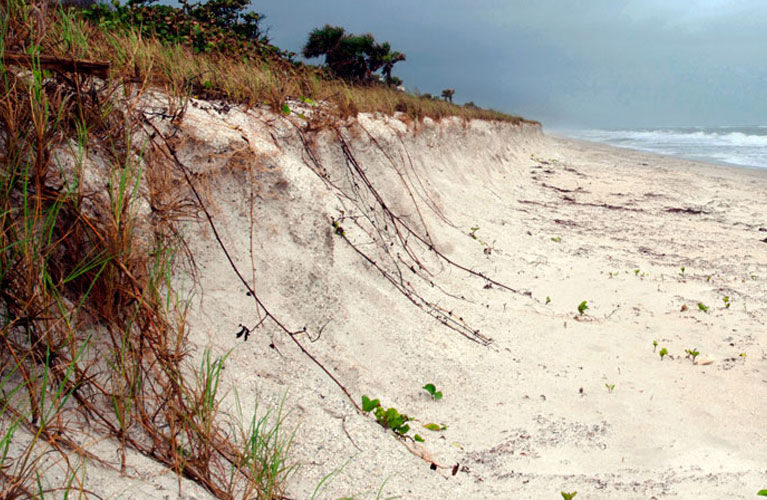
INDIAN RIVER COUNTY — Oceanfront residents from Windsor to John’s Island won’t get storm-battered dunes repaired until at least November, but while the county waits for a permit on a new sand source, staffers and consultants are resuscitating the idea of artificial reefs to stop further beach erosion.
As taxpayers face another whopping bill for beach replenishment – an estimated $5.4 million to replace trucked-in sand put there for $15 million in 2012 – finding another, less ephemeral solution to beach erosion has the county updating its Beach Preservation Plan.
In 2011 there was much excitement as the area’s mayors got together to push for proactive erosion control via artificial reefs and other structures. All five county commissioners joined the mayors and dozens of concerned citizens to vet options for artificial reefs at a September 2011 workshop.
Despite objections voiced by skeptics, including Vero’s then-Mayor Jay Kramer, a majority of the group pushed for a quarter-million dollars for Florida Tech professor and beach sand expert Gary Zarillo to do a feasibility study.
But, as often happens with government initiatives, more than two years went by and no reefs materialized.
In March 2012, when the City of Vero Beach asked the county for bed tax money to shore up the Conn Beach boardwalk laid bare of sand by a Nor’easter, County Budget Director Jason Brown told the Tourist Development Council the county was trying to find money in the budget to fund the study.
“We do not have that ($250,000) reef study funded, but that’s another mid-year request that we’ve gotten,” Brown said.
Eight months later, Hurricane Sandy tore up the Atlantic coast and chewed up Vero’s beaches. All told, the 6.6-mile stretch of north beach called Sector 3 has lost more than $5 million in sand over the past two years. On top of that, Vero spent nearly $150,000 on emergency dune repair. The value of the sand lost in other parts of the county’s 22-mile shoreline has not been tallied.
The county found most of that quarter-million dollars in optional sales tax money this past fall and hired CBI Consultants Inc. to tackle an update of the Beach Preservation Plan this year for $199,953. The dusted-off concept of artificial reefs got its public reveal in a Beach Preservation Plan charrette just before Christmas.
Though several of the county’s public works staff and engineering consultants showed up, only eight members of the public attended – two of them students from Indian River Charter High School who apparently needed to attend a government meeting for class credit.
Coastal Engineer James Gray said the county has not narrowed the options of what it might put on the beaches. There’s no ranking and nothing has necessarily been ruled out.
“We do not have a specific coastal structure determination at this time,” Gray said. “We are currently identifying areas of the shoreline where a structural alternative (type, size, and location) could be considered as a viable recommendation.”
Graves reported back to the Vero Beach City Council, urging concerned citizens watching the meeting to pay attention and voice their opinions before any recommendations are made.
“I would encourage anyone in the public who goes to our beaches, lives on the beaches, has property on the beaches to attend because they’re looking for public feedback as to the structures they’re going to put in place,” Graves said.
“Some of them, when they put them up on screen, that are in place in other cities, people knew immediately that wasn’t what we want on our beaches,” she said. “One looked like a pier had been there and then the top blew in.”
The structures to which Graves referred are called “pile-panel groins” and that’s exactly what they look like – the wooden pilings of a dock or pier – without the walkway decking surface.
A beefed-up cement version of this, complete with rusty metal piping sticking out, is called a Permeable Adjustable Groin or PAG.
Unfathomable as it seems that a community would design and install such an eyesore on a busy tourist beach, consultants showed photographs of such projects in action in other Florida cities. Unsightly as they may be, they’re not cheap, with published estimates of several thousand dollars per linear foot of groin.
Other photographs depicted rocks called “rock groins” dumped in piles perpendicular with the shoreline every so often down the beach. Breakwaters are piles of rocks dumped in rows parallel to the shoreline. Concrete submerged breakwaters or “reef balls” resemble massive aquarium caves.
News reports cite a wide range of costs for “rock groins,” from $1,200 to $6,500 per linear foot, depending upon the type of rock used.
The Reef Ball Foundation lists retail prices for the largest or Goliath reef balls, which are four feet tall and have a diameter of six feet, at $450 each, plus transportation and delivery.
Indian River County has some experience with PEP reefs, as it sunk 200 of the concrete units staggered across 3,000 feet from the Village Spires south to Humiston Park.
That PEP reef settled partially into the ocean floor shortly after being installed at a cost of $2 million in 1996.
The Beach Preservation Plan is on a timeline where options for management strategies are being worked out this month, to be modeled in April and cost estimates to be added in May.
Storm damage analyses are being done in February and March. An economic analysis is set for June with a draft of the report slated for July.
Gray said the next Beach Preservation Plan workshop is tentatively scheduled for June.



